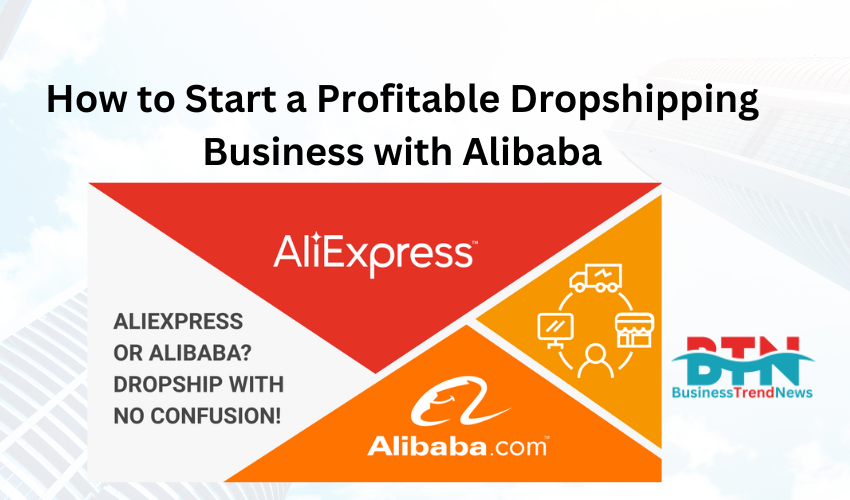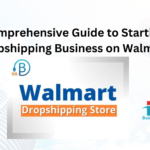![]()
Dropshipping has become one of the most popular ways to start an online business, thanks to its low startup costs and the ability to sell products without holding inventory. Alibaba, one of the world’s largest B2B marketplaces, offers a vast array of products that can be dropshipped to customers around the globe. In this guide, we’ll walk you through everything you need to know about starting a successful dropshipping business using Alibaba.
What is Dropshipping?
Before diving into the specifics of using Alibaba for dropshipping, it’s essential to understand what dropshipping is. Dropshipping is a retail fulfillment method where a store doesn’t keep the products it sells in stock. Instead, when a store sells a product, it purchases the item from a third party and has it shipped directly to the customer. As a result, the seller never sees or handles the product.
This model allows entrepreneurs to start an e-commerce business without the overhead of managing inventory, making it an attractive option for those looking to enter the world of online retail with minimal risk.
Why Choose Alibaba for Dropshipping?
Alibaba is a giant in the world of e-commerce, particularly for business-to-business (B2B) transactions. It connects suppliers and manufacturers from around the world with buyers, offering a vast range of products at competitive prices. Here’s why Alibaba is an excellent choice for your dropshipping business:
- Extensive Product Range: Alibaba offers millions of products in virtually every category imaginable, from electronics to fashion to home goods.
- Low Prices: Because Alibaba connects you directly with manufacturers, you can often find products at lower prices than on other platforms.
- Supplier Variety: With thousands of suppliers to choose from, you can find multiple options for the same product, allowing you to compare prices and quality.
- Customizable Products: Many Alibaba suppliers offer customization options, allowing you to create private-label products that can set your store apart from the competition.
Step 1: Finding a Profitable Niche
The first step in starting a dropshipping business with Alibaba is identifying a profitable niche. A niche is a specific segment of a market that you’ll target with your products. Choosing the right niche is crucial for your success, as it will determine the types of products you sell and the customers you attract.
How to Choose a Niche
- Passion and Interest: Start by considering what you’re passionate about or interested in. Running a business around something you care about will keep you motivated.
- Market Demand: Use tools like Google Trends, Amazon Best Sellers, and keyword research to gauge market demand for different products. Look for products that have a steady demand and are not overly saturated.
- Profitability: Ensure that the products you’re considering have a healthy profit margin. Typically, a profit margin of at least 30-50% is ideal for dropshipping.
- Competition Analysis: Analyze your potential competition. A highly competitive market may be harder to penetrate, while a market with no competition might indicate low demand. Strike a balance by choosing a niche with moderate competition.
Popular Dropshipping Niches
- Health and Wellness
- Fashion and Apparel
- Home and Kitchen Products
- Electronics and Gadgets
- Pet Supplies
- Fitness and Sports Equipment
Step 2: Researching and Choosing Suppliers on Alibaba
Once you’ve identified your niche, the next step is to find reliable suppliers on Alibaba. The success of your dropshipping business largely depends on the quality of your suppliers, so it’s crucial to choose carefully.
How to Search for Suppliers on Alibaba
- Search by Product: Start by searching for the products you want to sell using relevant keywords. Alibaba’s search engine will return a list of suppliers offering those products.
- Filter Results: Use filters to narrow down your options. You can filter by supplier type (e.g., manufacturer, trading company), country/region, minimum order quantity (MOQ), and more.
- Check Supplier Credentials: Look for suppliers with good reviews, a high transaction level, and a gold supplier status. Gold suppliers are those who have been verified by Alibaba as legitimate businesses.
- Read Reviews and Ratings: Customer reviews and ratings provide insight into the supplier’s reliability, product quality, and customer service.
- Request Samples: Before making a bulk purchase, request samples from potential suppliers. This allows you to assess the product’s quality firsthand.
Red Flags to Watch Out For
- Lack of Communication: If a supplier is slow to respond or doesn’t communicate clearly, it may be a sign of poor customer service.
- Unrealistically Low Prices: If a price seems too good to be true, it probably is. Extremely low prices may indicate low-quality products.
- No Reviews or Bad Reviews: Suppliers with no reviews or a significant number of negative reviews should be approached with caution.
Step 3: Negotiating with Suppliers
Negotiating with suppliers on Alibaba is a common practice and can lead to better prices, terms, and conditions. Here’s how to negotiate effectively:
- Be Professional: Approach negotiations professionally. Clearly state your needs and be respectful in your communication.
- Start with a Small Order: If you’re unsure about a supplier, start with a small order to test the waters before committing to a larger purchase.
- Ask for Discounts: Many suppliers are open to offering discounts, especially for bulk orders or long-term partnerships. Don’t be afraid to ask.
- Discuss Shipping Options: Shipping can be a significant cost in dropshipping. Discuss different shipping options with your supplier and choose the one that balances cost and delivery time.
- Clarify Payment Terms: Agree on payment terms that work for both parties. Alibaba offers secure payment options like Trade Assurance, which protects your payments.
Step 4: Setting Up Your Online Store
With your niche chosen and suppliers lined up, it’s time to set up your online store. There are several e-commerce platforms you can use to create a professional-looking store without needing technical expertise.
Choosing an E-commerce Platform
- Shopify: Shopify is one of the most popular e-commerce platforms for dropshipping. It’s user-friendly, offers numerous templates, and has built-in tools for managing your store, inventory, and orders.
- WooCommerce: WooCommerce is a WordPress plugin that allows you to turn your WordPress site into an online store. It’s highly customizable but requires some technical knowledge.
- BigCommerce: BigCommerce is another robust e-commerce platform that offers scalability and a wide range of features for growing businesses.
- Wix: Wix is a drag-and-drop website builder that’s great for beginners. It offers a simple way to create an e-commerce store with customizable templates.
Designing Your Store
- Choose a Theme: Select a theme or template that suits your brand and niche. Ensure it’s mobile-friendly, as many customers shop on their smartphones.
- Add Products: Upload the products you plan to sell, including high-quality images, detailed descriptions, and pricing information. Organize products into categories to make navigation easier for customers.
- Set Up Payment Gateways: Integrate payment gateways like PayPal, Stripe, or credit card processors to accept payments from customers.
- Configure Shipping Settings: Set up your shipping options based on the shipping methods you’ve arranged with your suppliers. You can offer free shipping, flat-rate shipping, or real-time shipping rates.
- Optimize for SEO: Optimize your product pages, category pages, and blog content for search engines. Use relevant keywords, meta descriptions, and alt tags to improve your store’s visibility in search results.
Step 5: Marketing Your Dropshipping Business
Marketing is crucial for driving traffic to your online store and converting visitors into customers. Here are some effective marketing strategies for your dropshipping business:
1. Content Marketing
Content marketing involves creating and sharing valuable content to attract and engage your target audience. Consider starting a blog on your website where you can write articles related to your niche. For example, if you’re selling fitness products, you could write articles on workout tips, nutrition advice, and product reviews.
2. Social Media Marketing
Social media platforms like Instagram, Facebook, Pinterest, and TikTok are powerful tools for promoting your products. Use these platforms to showcase your products, engage with your audience, and run targeted ads.
- Instagram: Use high-quality images and videos to showcase your products. Consider working with influencers in your niche to reach a larger audience.
- Facebook: Create a Facebook page for your store and use Facebook Ads to target specific demographics and interests.
- Pinterest: Pinterest is particularly effective for niches like fashion, home decor, and DIY. Create visually appealing pins that link back to your product pages.
3. Email Marketing
Email marketing is an excellent way to build relationships with your customers and encourage repeat business. Collect email addresses through a signup form on your website and send regular newsletters featuring new products, promotions, and content.
- Automated Emails: Set up automated email sequences for welcome emails, abandoned cart reminders, and post-purchase follow-ups.
- Segmentation: Segment your email list based on customer behavior, preferences, and purchase history to send more personalized emails.
4. Search Engine Optimization (SEO)
SEO is essential for driving organic traffic to your store. Focus on optimizing your website for relevant keywords, improving page load speed, and creating high-quality content that answers your audience’s questions.
- On-Page SEO: Optimize product titles, descriptions, meta tags, and images with relevant keywords.
- Off-Page SEO: Build backlinks from reputable websites, collaborate with bloggers, and get featured in industry-related publications.
5. Pay-Per-Click (PPC) Advertising
PPC advertising allows you to pay for traffic to your website. Google Ads and Facebook Ads are popular PPC platforms that enable you to target specific audiences based on keywords, demographics, and interests.
- Google Ads: Create targeted ad campaigns based on search queries relevant to your products.
- Facebook Ads: Use Facebook’s robust targeting options to reach your ideal customers with personalized ads.
Step 6: Managing Orders and Customer Service
Efficient order management and excellent customer service are vital for the success of your dropshipping business. Here’s how to stay on top of your operations:
Order Fulfillment
- Automate Orders: Use apps like Oberlo (for Shopify) or AliDropship (for WooCommerce) to automate the order fulfillment process. These apps can automatically send orders to your suppliers, track shipments, and update your store’s inventory.
- Monitor Supplier Performance: Regularly check in with your suppliers to ensure they’re fulfilling orders promptly and accurately. Address any issues that arise as soon as possible.
Customer Service
- Respond Quickly: Provide prompt and courteous responses to customer inquiries. Use live chat, email, or social media to communicate with customers.
- Handle Returns and Refunds: Establish a clear returns and refunds policy and communicate it to your customers. Work with your suppliers to handle returns efficiently.
- Build Customer Loyalty: Encourage repeat business by offering loyalty programs, discounts for returning customers, and personalized recommendations.
Step 7: Scaling Your Dropshipping Business
As your dropshipping business grows, you’ll want to scale your operations to increase revenue and expand your brand. Here are some strategies for scaling:
- Expand Product Offerings: Introduce new products or variations to your existing product line. Look for complementary products that your customers might be interested in.
- Explore New Markets: Consider expanding into new geographic markets or customer segments. Use market research to identify opportunities for growth.
- Invest in Marketing: Increase your marketing budget to reach more customers. Experiment with new marketing channels and campaigns to see what works best.
- Improve Your Website: Optimize your website for speed, usability, and conversion rates. A faster, more user-friendly website can lead to higher sales.
- Build a Brand: Focus on building a strong brand identity that resonates with your target audience. This includes consistent branding across all your marketing channels, packaging, and customer communication.
Conclusion
Starting a dropshipping business with Alibaba offers an accessible and potentially profitable way to enter the world of e-commerce. By carefully selecting a niche, researching and partnering with reliable suppliers, setting up a professional online store, and effectively marketing your products, you can build a successful dropshipping business.
While the journey may involve challenges, especially in managing supplier relationships and ensuring customer satisfaction, the rewards of running a thriving online business can be well worth the effort. Whether you’re looking to supplement your income or create a full-time business, dropshipping with Alibaba can provide the foundation you need to succeed in the competitive world of e-commerce.



